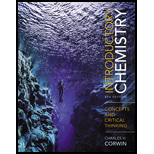
(a)
Interpretation:
The equilibrium constant expression for the given
Concept introduction:
(b)
Interpretation:
The equilibrium constant expression for the given chemical reaction is to be stated.
Concept introduction:
Chemical equilibrium is a state in which forward rate of reaction is equal to reverse rate of reaction at a given temperature. Law of chemical equilibrium states that at a given temperature ratio of molar concentration of products, each raised to a power equal to its coefficient, to the molar concentration of reactants, each raised to their coefficient, is constant.
(c)
Interpretation:
The equilibrium constant expression for the given chemical reaction is to be stated.
Concept introduction:
Chemical equilibrium is a state in which forward rate of reaction is equal to reverse rate of reaction at a given temperature. Law of chemical equilibrium states that at a given temperature ratio of molar concentration of products, each raised to a power equal to its coefficient, to the molar concentration of reactants, each raised to their coefficient, is constant.
Want to see the full answer?
Check out a sample textbook solution
Chapter 16 Solutions
Introductory Chemistry: Concepts and Critical Thinking Plus MasteringChemistry with eText -- Access Card Package
- At a temperature of 60 C, the vapor pressure of water is 0.196 atm. What is the value of the equilibrium constant KP for the transformation at 60 C? H2O(l)H2O(g)arrow_forwardAt a certain temperature, K=0.29 for the decomposition of two moles of iodine trichloride, ICl3(s), to chlorine and iodine gases. The partial pressure of chlorine gas at equilibrium is three times that of iodine gas. What are the partial pressures of iodine and chlorine at equilibrium?arrow_forwardSuppose a reaction has the equilibrium constant K = 1.3 108. What does the magnitude of this constant tell you about the relative concentrations of products and reactants that will be present once equilibrium is reached? Is this reaction likely to be a good source of the products?arrow_forward
- Show that the complete chemical equation, the total ionic equation, and the net ionic equation for the reaction represented by the equation KI(aq)+I2(aq)KI3(aq) give the same expression for the reaction quotient. KI3 is composed of the ions K+ and I3-.arrow_forwardWrite the equilibrium expression for the reaction of aqueous potassium hydroxide with aqueous calcium chloride yielding calcium hydroxide and potassium chloride. Keq = ____arrow_forwardWrite the equilibrium constant expression for the following reactions. (2 pts. Each)arrow_forward
- Identify the equilibrium constant expression for the following reaction 2 N2O5(g) ⇌ 4 NO2(g) + O2(g)arrow_forwardWrite the equilibrium expression for each of the following reactions: NO2 (g) ↔ NO (g) + 1/2 O2 (g)arrow_forwardConsider the following reaction at equilibrium: 2NO₂(g) ⇌ N₂O₄(g) The ∆H° for this reaction is < 0. If the volume of the container is decreased by ½ while the temperature is kept constant, in which direction will the equilibrium shift?arrow_forward
- Consider the following equi;ibrium: 3 HClO3 (aq) ⇌ HClO (aq) + 2 HClO4 (aq) If 0.15 M HClO and 0.15 M HClO4 are added to a container and sealed, calculate the equilibrium concentrations of all reactants and products, (HClO3, HClO and HClO4). Kc = 3.1 x1012arrow_forwardWrite the equilibrium constant expression for the following reaction: N2O (g) + NO2 (g) ⇌ 3NO (g)arrow_forwardWrite the equilibrium-constant expression for the reaction, NH3(aq) + H2O(l) ∆ NH4+(aq) + OH-(aq)arrow_forward
 Principles of Modern ChemistryChemistryISBN:9781305079113Author:David W. Oxtoby, H. Pat Gillis, Laurie J. ButlerPublisher:Cengage Learning
Principles of Modern ChemistryChemistryISBN:9781305079113Author:David W. Oxtoby, H. Pat Gillis, Laurie J. ButlerPublisher:Cengage Learning Chemistry: Principles and PracticeChemistryISBN:9780534420123Author:Daniel L. Reger, Scott R. Goode, David W. Ball, Edward MercerPublisher:Cengage Learning
Chemistry: Principles and PracticeChemistryISBN:9780534420123Author:Daniel L. Reger, Scott R. Goode, David W. Ball, Edward MercerPublisher:Cengage Learning Chemistry for Engineering StudentsChemistryISBN:9781337398909Author:Lawrence S. Brown, Tom HolmePublisher:Cengage Learning
Chemistry for Engineering StudentsChemistryISBN:9781337398909Author:Lawrence S. Brown, Tom HolmePublisher:Cengage Learning Chemistry: Principles and ReactionsChemistryISBN:9781305079373Author:William L. Masterton, Cecile N. HurleyPublisher:Cengage Learning
Chemistry: Principles and ReactionsChemistryISBN:9781305079373Author:William L. Masterton, Cecile N. HurleyPublisher:Cengage Learning Physical ChemistryChemistryISBN:9781133958437Author:Ball, David W. (david Warren), BAER, TomasPublisher:Wadsworth Cengage Learning,
Physical ChemistryChemistryISBN:9781133958437Author:Ball, David W. (david Warren), BAER, TomasPublisher:Wadsworth Cengage Learning,





